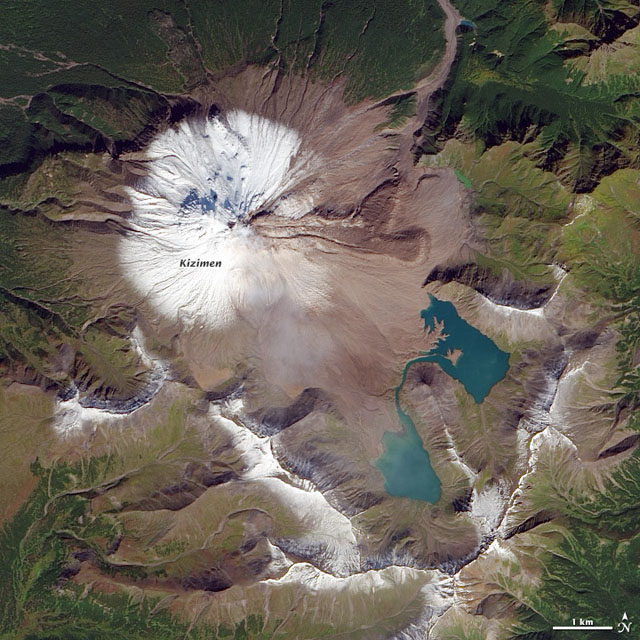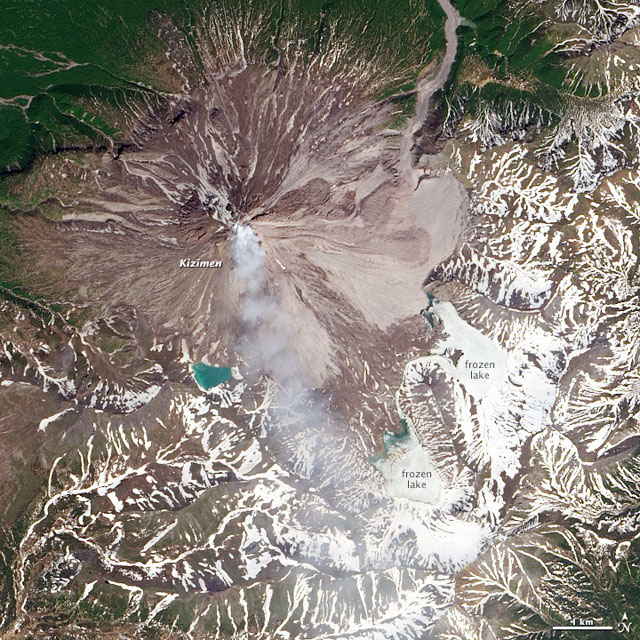Report on Kizimen (Russia) — April 2014
Bulletin of the Global Volcanism Network, vol. 39, no. 4 (April 2014)
Managing Editor: Richard Wunderman.
Kizimen (Russia) Evidence for eruption ceases after 9 December 2013; steaming continues
Please cite this report as:
Global Volcanism Program, 2014. Report on Kizimen (Russia) (Wunderman, R., ed.). Bulletin of the Global Volcanism Network, 39:4. Smithsonian Institution. https://doi.org/10.5479/si.GVP.BGVN201404-300230
Kizimen
Russia
55.131°N, 160.32°E; summit elev. 2334 m
All times are local (unless otherwise noted)
On 28 July 2014 KVERT (the Kamchatka Volcanic Eruptions Response Team) listed the recent Kizimen eruption as occurring during the interval 9 December 2010 to 9 December 2013 without any subsequent unrest. Our previous report (BGVN 38:04) noted seismicity, lava flows, ash plumes, and occasional pyroclastic flows during October 2011 to May 2013. In this report we note that the eruption continued, although lava extrusion was diminished, at least through mid-September 2013. After that time, the eruption became weak and ended on 9 December 2013. MODVOLC thermal alerts ceased during 12 July 2013 to at least as late as 25 July 2014.
According to KVERT, moderate seismic activity continued during 31 May-13 September 2013. Video and satellite data showed that lava continued to extrude from the summit during this time, producing incandescence, strong gas-and-steam activity, and hot avalanches on the W and E flanks. The Aviation Color Code remained at Orange (Level 3 of 4; Aviation Color Codes are described more fully in figure 16 in BGVN 38:04).
By mid-September 2013, activity had decreased. KVERT reported that both video and satellite data indicated less incandescence from the crater during the previous few weeks, and seismicity had decreased significantly by the end of August 2013. Lava may have continued to extrude from the crater at a low rate. On 13 September 2013, the Aviation Color Code was lowered to Yellow (Level 2).
According to KVERT, weak seismic activity continued during 29 November-6 December 2013. Video showed gas-and-steam activity and satellite images showed a weak thermal anomaly on a daily basis; those anomalies were probably too weak to trigger a MODVOLC thermal alert. On 9 December 2013, the Alert Level was lowered to Green.
The number of MODVOLC thermal alerts was relatively low through May 2013 (see figure 17 in BGVN 38:04), and during 2013 decreased further during the months of June (7 alerts), July (2 alerts), and August (6 alerts). From 12 July 2013 through 15 July 2014, MODVOLC thermal alerts were absent.
Two natural-color images of Kizimen collected by the Operational Land Imager on Landsat 8 appear in figures 20 and 21. The respective images depict seasonal changes from early fall 2013 to late spring 2014 and show ongoing steam emission on 17 June 2014.
Geological Summary. Kizimen is an isolated, conical stratovolcano that is morphologically similar to St. Helens prior to its 1980 eruption. The summit consists of overlapping lava domes, and blocky lava flows descend the flanks of the volcano, which is the westernmost of a volcanic chain north of Kronotsky volcano. The 2334-m-high edifice was formed during four eruptive cycles beginning about 12,000 years ago and lasting 2000-3500 years. The largest eruptions took place about 10,000 and 8300-8400 years ago, and three periods of long-term lava dome growth have occurred. The latest eruptive cycle began about 3000 years ago with a large explosion and was followed by intermittent lava dome growth lasting about 1000 years. An explosive eruption about 1100 years ago produced a lateral blast and created a 1.0 x 0.7 km wide crater breached to the NE, inside which a small lava dome (the fourth at Kizimen) has grown. Prior to 2010, only a single explosive eruption, during 1927-28, had been recorded in historical time.
Information Contacts: Kamchatka Volcanic Eruptions Response Team (KVERT), Far East Division, Russian Academy of Sciences, 9 Piip Blvd., Petropavlovsk-Kamchatsky, 683006, Russia (URL: http://www.kscnet.ru/ivs/); MODVOLC - HIGP, Hawai'i Institute of Geophysics and Planetology (HIGP), MODVOLC Thermal Alerts System, School of Ocean and Earth Science and Technology (SOEST), Univ. of Hawai'i, 2525 Correa Road, Honolulu, HI 96822, USA (URL: http://modis.higp.hawaii.edu/); and NASA Earth Observatory, EOS Project Science Office, NASA Goddard Space Flight Center, Goddard, Maryland, USA (URL: http://earthobservatory.nasa.gov/).



